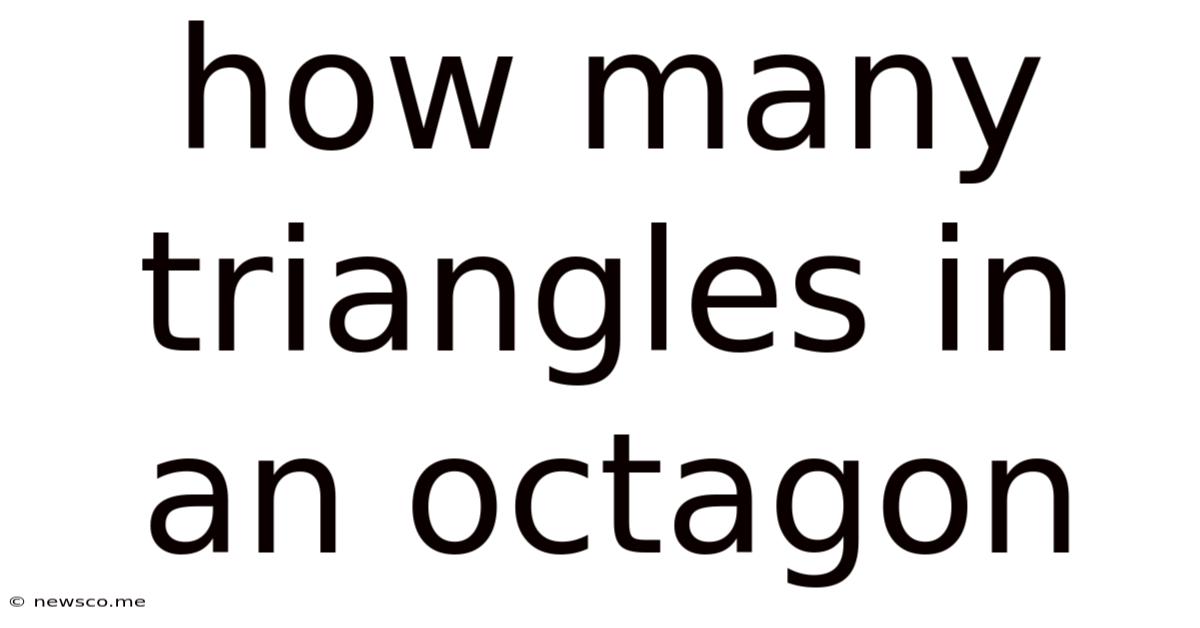How Many Triangles In An Octagon
News Co
Mar 22, 2025 · 4 min read

Table of Contents
How Many Triangles in an Octagon? A Comprehensive Guide
Counting triangles within a geometric shape like an octagon might seem like a simple task at first glance. However, as the number of sides increases, the complexity of the problem grows exponentially. This article will delve deep into the methods of determining the number of triangles in a regular octagon, exploring different approaches and providing a comprehensive understanding of the underlying mathematical principles. We'll tackle both the simple cases and the more challenging scenarios, ultimately equipping you with the tools to solve similar problems for other polygons.
Understanding the Problem: Triangles within an Octagon
An octagon is an eight-sided polygon. The challenge lies in systematically identifying and counting all possible triangles that can be formed by connecting any three vertices (corners) of the octagon. Simply looking at an octagon and trying to count the triangles manually is impractical and prone to errors, especially for more complex shapes. We need a structured approach.
Method 1: Combinatorial Approach (Using Combinations)
This method leverages the principles of combinatorics. Since a triangle is formed by selecting three vertices from the octagon's eight vertices, we can use the combination formula to calculate the total number of possible triangles.
The combination formula is:
ⁿCᵣ = n! / (r! * (n-r)!)
Where:
- n is the total number of items (vertices in our case, which is 8).
- r is the number of items we choose at a time (3 vertices to form a triangle).
- ! denotes the factorial (e.g., 5! = 5 * 4 * 3 * 2 * 1).
Applying this to our octagon:
⁸C₃ = 8! / (3! * (8-3)!) = 8! / (3! * 5!) = (8 * 7 * 6) / (3 * 2 * 1) = 56
Therefore, there are 56 possible triangles that can be formed by connecting any three vertices of an octagon. This method directly calculates the total number of triangles without needing to visualize or manually count them.
Important Consideration: Non-Intersecting Triangles
The combinatorial approach, as described above, counts all possible triangles, including those whose sides intersect internally. For instance, it includes triangles formed by connecting vertices that cross other sides of the octagon. While these are valid triangles geometrically, they might not be the type of triangles you are looking for in certain applications. If you specifically need to count only non-intersecting triangles, a more intricate approach is required. This is a significantly more complex problem and usually necessitates using more advanced mathematical techniques.
Method 2: Visualizing and Counting (For Smaller Polygons)
For simpler polygons, like a triangle, quadrilateral, pentagon, or even a hexagon, it’s feasible to visually identify and count the triangles. However, this method rapidly becomes impractical for larger polygons such as octagons and beyond. Let's illustrate with a smaller polygon for illustrative purposes.
Consider a quadrilateral (four-sided polygon). You can form four triangles by connecting one vertex to the opposite vertices. This is a relatively simple case to visualize.
Method 3: Recursive Approach (More Advanced)
A recursive approach is more suited to larger polygons and provides a more systematic and generalizable method. This approach involves breaking down the problem into smaller, self-similar subproblems. It is beyond the scope of a basic explanation but involves principles of recursive functions and dynamic programming. Essentially, the concept involves finding a pattern in the way triangles are formed as you increase the number of sides and using that pattern to calculate the number for an octagon.
Types of Triangles within an Octagon
Understanding the different types of triangles helps in visualizing and analyzing the problem. Within an octagon, you can have various types of triangles based on their properties:
- Isosceles Triangles: These have at least two sides of equal length.
- Equilateral Triangles: All three sides are equal in length. In a regular octagon, it's unlikely you'll find many, if any, equilateral triangles.
- Scalene Triangles: All three sides have different lengths. This is likely the most common type of triangle within a regular octagon.
- Right-angled Triangles: One angle measures 90 degrees.
- Acute-angled Triangles: All three angles are less than 90 degrees.
- Obtuse-angled Triangles: One angle is greater than 90 degrees.
Applications and Extensions
Understanding how to count triangles within polygons has applications in various fields, including:
- Computer graphics: Triangulation is a fundamental technique in computer graphics for rendering and modeling complex shapes.
- Geometry and Combinatorics: These problems are excellent exercises in developing combinatorial thinking and problem-solving skills.
- Network Analysis: The principles can be applied to network analysis where nodes represent vertices, and connections represent edges.
- Physics and Engineering: In certain problems involving structural analysis or simulations, understanding triangle formation can be crucial.
Conclusion: The Power of Systematic Approaches
While simply looking at an octagon and attempting to count triangles manually is ineffective, employing structured mathematical approaches like the combinatorial method provides a clear and accurate solution. The combinatorial approach gives a total of 56 triangles. Remember that this includes triangles whose sides intersect within the octagon. Determining the number of non-intersecting triangles is significantly more challenging and requires more advanced mathematical techniques. This exploration underscores the importance of choosing the right mathematical tool for solving geometric problems, and it highlights how even seemingly straightforward problems can reveal significant mathematical depth. Using this guide, you can now confidently approach similar counting problems for other polygons.
Latest Posts
Related Post
Thank you for visiting our website which covers about How Many Triangles In An Octagon . We hope the information provided has been useful to you. Feel free to contact us if you have any questions or need further assistance. See you next time and don't miss to bookmark.